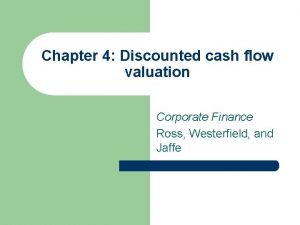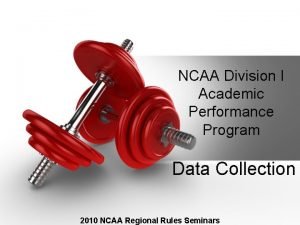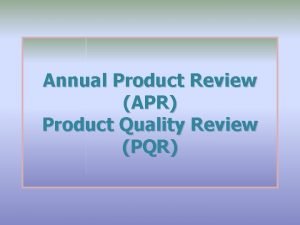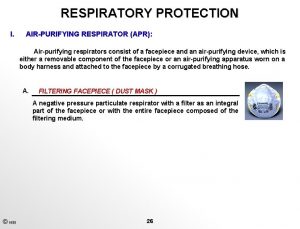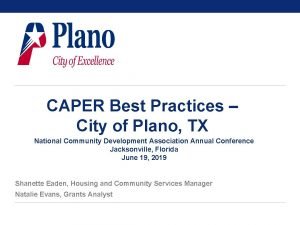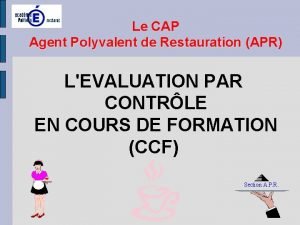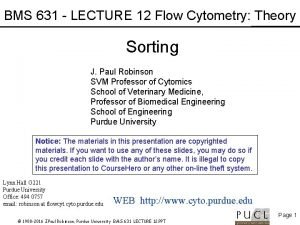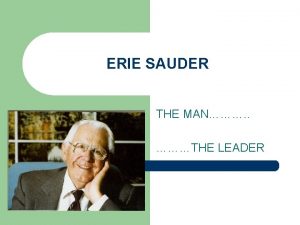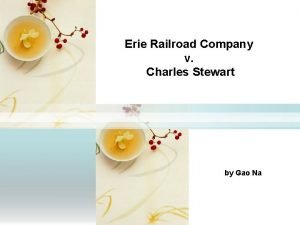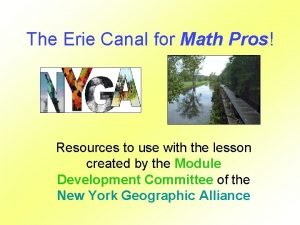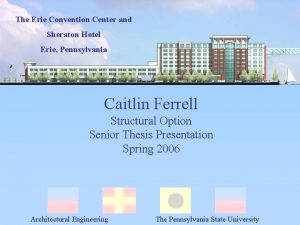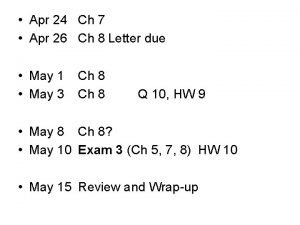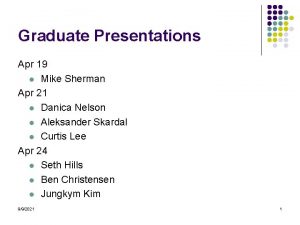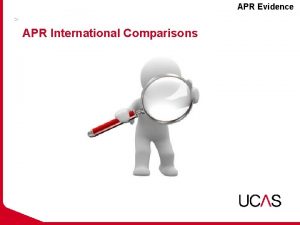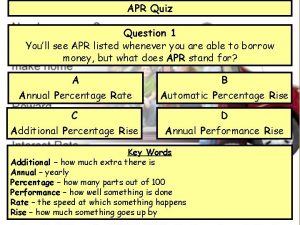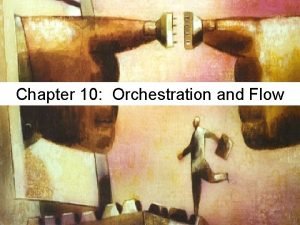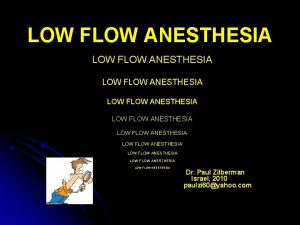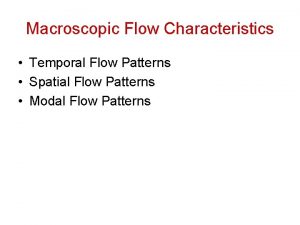Lecture 27 Apr 18 2018 Erie Erie flow











































![Shady Grove also ranks § 901(b) as “procedural” because “nothing in [the statute] suggests Shady Grove also ranks § 901(b) as “procedural” because “nothing in [the statute] suggests](https://slidetodoc.com/presentation_image_h2/5cb77c447a7e319b3aff2af8e9018224/image-44.jpg)







![The D Corp. [hereinafter D] is incorporated in Virginia with its principal place of The D Corp. [hereinafter D] is incorporated in Virginia with its principal place of](https://slidetodoc.com/presentation_image_h2/5cb77c447a7e319b3aff2af8e9018224/image-52.jpg)

![In California, the D Corp [hereinafter D] (incorporated in Delaware with its principal place In California, the D Corp [hereinafter D] (incorporated in Delaware with its principal place](https://slidetodoc.com/presentation_image_h2/5cb77c447a7e319b3aff2af8e9018224/image-54.jpg)

- Slides: 55

Lecture 27 Apr. 18, 2018

Erie

Erie flow chart. . .

is the federal court sitting in diversity/alienage or is there a cause of action with supplemental jurisdiction? NO? - Example: P sues D in federal court in New York under federal securities law no Erie problem - no need to worry about state procedural law

why don’t the twin aims apply in federal questions cases…?

is the federal court sitting in diversity/alienage or is there a cause of action with supplemental jurisdiction? YES?

is the relevant federal procedural law mandated by the U. S. Constitution? E. g. 7 th A if yes it applies

is the relevant federal procedural law a federal statute? if yes it applies if it is arguably procedural it does not matter if it leads to forum shopping

really? Could Congress pass a 3 year statute of limitations for tort actions brought in federal court that displaced a 2 -year statute of limitations that a state had bound up with its cause of action?

is the relevant federal procedural law a Fed. R. Civ. P. ? if yes only questions are - is it arguably procedural and - does it abridge enlarge or modify substantive rights

is the relevant federal procedural law common law? - remember, includes cases in which the federal court simply doesn’t have anything on point, but doesn’t do what the forum state does

1 st is the state rule is bound up with the cause of action (Byrd) – if so, use state law examples? - statute of limitations folded into a statutory cause of action - burden of proof for contributory negligence

really? could a state compel federal courts to limit the page length of briefs by folding up a rule into the cause of action. . . ?

also - what about a state’s interest in its law applying independently of the cause of action?

if not bound up…

look to twin aims of Erie - would having a federal common law rule different from the forum state’s rule lead to… - vertical forum shopping - inequitable administration of the laws?

forum shopping in general, not in the particular case

if no problem of forum shopping/ineq. admin. , then use uniform federal common law rule example: federal common law rule concerning service

if there is a problem of forum shopping/ineq. admin. , then use forum state rule - unless sufficiently strong countervailing federal interests in favor of the uniform federal common law rule

a federal court sitting in diversity in Del. needs to determine whether Pa. or NY law applies can it use federal common law choice-of-law rules?

Klaxon v. Stentor Mfg. Co. (US 1941)

Klaxon applies to the interpretation of state law too…

Semtek v. Lockheed Martin, 531 U. S. 497 (2001)

what about the substantive right limitation in the REA?

Shady Grove Orthoped. Assoc. V. Allstate (U. S. 2010)

Allstate refused to pay NY statutory interest on late payment of claims - class action against Allstate for the interest

N. Y. Civ. Prac. Law Ann. § 901 (no class actions for penalties or statutory minimum damages)

Rule 23(a) provides: “(a) Prerequisites. One or more members of a class may sue or be sued as representative parties on behalf of all members only if: “(1) the class is so numerous that joinder of all members is impracticable; “(2) there are questions of law or fact common to the class; “(3) the claims or defenses of the representative parties are typical of the claims or defenses of the class; and “(4) the representative parties will fairly and adequately protect the interests of the class. ” Subsection (b) says that “[a] class action may be maintained if Rule 23 (a) is satisfied and if” the suit falls into one of three described categories (irrelevant for present purposes).

Scalia (with Thomas, Roberts & Sotomayor)

“The fundamental difficulty with …these arguments is that the substantive nature of New York’s law, or its substantive purpose, makes no difference. A Federal Rule of Procedure is not valid in some jurisdictions and invalid in others—or valid in some cases and invalid in others—depending upon whether its effect is to frustrate a state substantive law (or a state procedural law enacted for substantive purposes). That could not be clearer in Sibbach…”

“In sum, it is not the substantive or procedural nature or purpose of the affected state law that matters, but the substantive or procedural nature of the Federal Rule. We have held since Sibbach , and reaffirmed repeatedly, that the validity of a Federal Rule depends entirely upon whether it regulates procedure. If it does, it is authorized by § 2072 and is valid in all jurisdictions, with respect to all claims, regardless of its incidental effect upon state-created rights. ”

assume there is a new FRCP that determines who has the burden of proof for contributory negligence is it valid, accd to Scalia?

The dissent’s approach of determining whether state and federal rules conflict based on the subjective intentions of the state legislature is an enterprise destined to produce “confusion worse confounded. ” It would mean, to begin with, that one State’s statute could survive pre-emption (and accordingly affect the procedures in federal court) while another State’s identical law would not, merely because its authors had different aspirations. It would also mean that district courts would have to discern, in every diversity case, the purpose behind any putatively pre-empted state procedural rule, even if its text squarely conflicts with federal law.

Stevens

Stevens: The New York law at issue, N. Y. Civ. Prac. Law Ann. (CPLR) § 901(b) (West 2006), is a procedural rule that is not part of New York’s substantive law. Accordingly, I agree with Justice Scalia that Federal Rule of Civil Procedure 23 must apply in this case and join Parts I and II–A of the Court’s opinion. But I also agree with Justice Ginsburg that there are some state procedural rules that federal courts must apply in diversity cases because they function as a part of the State’s definition of substantive rights and remedies.

“Justice Scalia believes that the sole Enabling Act question is whether the federal rule “really regulates procedure, ” which means, apparently, whether it regulates “the manner and the means by which the litigants’ rights are enforced”…. I respectfully disagree. [I]t ignores the second limitation that such rules also “not abridge, enlarge or modify any substantive right, ” § 2072(b) (emphasis added), and in so doing ignores the balance that Congress struck between uniform rules of federal procedure and respect for a State’s construction of its own rights and remedies. It also ignores the separation-of-powers presumption, and federalism presumption that counsel against judicially created rules displacing state substantive law. ”

why was § 901(b) procedural, according to Stevens?

The text of CPLR § 901(b) expressly and unambiguously applies not only to claims based on New York law but also to claims based on federal law or the law of any other State. And there is no interpretation from New York courts to the contrary. It is therefore hard to see how § 901(b) could be understood as a rule that, though procedural in form, serves the function of defining New York’s rights or remedies.

Ginsburg (with Kennedy, Breyer, & Alito)

Ginsburg: “The Court today approves Shady Grove’s attempt to transform a $500 case into a $5, 000 award, although the State creating the right to recover has proscribed this alchemy. If Shady Grove had filed suit in New York state court, the 2% interest payment authorized by New York Ins. Law Ann. § 5106(a) (West 2009) as a penalty for overdue benefits would, by Shady Grove’s own measure, amount to no more than $500. ”

“In sum, both before and after Hanna , the above-described decisions show, federal courts have been cautioned by this Court to ‘interpre[t] the Federal Rules … with sensitivity to important state interests, ’ and a will ‘to avoid conflict with important state regulatory policies. ’ The Court veers away from that approach…in favor of a mechanical reading of Federal Rules, insensitive to state interests and productive of discord. ”

Rule 23 prescribes the considerations relevant to class certification and postcertification proceedings—but it does not command that a particular remedy be available when a party sues in a representative capacity. Section 901(b), in contrast, trains on that latter issue. … In this regard, it is immaterial that § 901(b) bars statutory penalties in wholesale, rather than retail, fashion. The New York Legislature could have embedded the limitation in every provision creating a cause of action for which a penalty is authorized; § 901(b) operates as shorthand to the same effect. It is as much a part of the delineation of the claim for relief as it would be were it included claim by claim in the New York Code.

Shady Grove urges that the class-action bar in § 901(b) must be regarded as “procedural” because it is contained in the CPLR, which “govern[s] the procedure in civil judicial proceedings in all courts of the state. ” Placement in the CPLR is hardly dispositive. The provision held “substantive” for Erie purposes in Gasperini is also contained in the CPLR (§ 5501(c)), as are limitations periods, prescriptions plainly “substantive” for Erie purposes however they may be characterized for other purposes.
![Shady Grove also ranks 901b as procedural because nothing in the statute suggests Shady Grove also ranks § 901(b) as “procedural” because “nothing in [the statute] suggests](https://slidetodoc.com/presentation_image_h2/5cb77c447a7e319b3aff2af8e9018224/image-44.jpg)
Shady Grove also ranks § 901(b) as “procedural” because “nothing in [the statute] suggests that it is limited to rights of action based on New York state law, as opposed to federal law or the law of other states”; instead it “applies to actions seeking penalties under any statute. ” It is true that § 901(b) is not specifically limited to claims arising under New York law. But neither is it expressly extended to claims arising under foreign law. … Shady Grove overlooks the most likely explanation for the absence of limiting language: New York legislators make law with New York plaintiffs and defendants in mind, i. e. , as if New York were the universe.

what cases would help you decide whether § 901(b) is substantive or procedural

a class action for statutory penalties under New York law brought in state court in New York?

a class action for statutory penalties under Pennsylvania law brought in state court in New York?

a class action for statutory penalties under New York law brought in state court in Connecticut?

does Twiqbal apply to a federal court sitting in diversity?

exam

st 1 Restatement choice-of-law questions interest analysis choice-of-law questions choice-of-law clause questions constitutional questions choice of law & jurisdictional limitations full faith and credit questions Erie policy questions…
![The D Corp hereinafter D is incorporated in Virginia with its principal place of The D Corp. [hereinafter D] is incorporated in Virginia with its principal place of](https://slidetodoc.com/presentation_image_h2/5cb77c447a7e319b3aff2af8e9018224/image-52.jpg)
The D Corp. [hereinafter D] is incorporated in Virginia with its principal place of business in Alabama. At a convenience store in California, P (a domiciliary of California) bought a lighter manufactured by D in a plant in Alabama. Upon buying the lighter, P took it home, where he modified it to make it possible to increase the size of the flame beyond what the lighter originally allowed. On a trip to New York, the lighter exploded, injuring P. P sued D in federal court in Virginia for negligent manufacturing. D argued that under Alabama, California and Virginia law, if P is found to have been contributorily negligent in altering the lighter, he should be denied recovery. P argues that New York law of comparative fault applies, which allows P to recover from D even if his negligence contributed to the accident (although P’s damages would be reduced by his degree of fault). Which law applies and why? 7 points.

P (a domiciliary of Ontario) and D (a domiciliary of Ontario) are students at the University of Michigan at Ann Arbor. D was driving the two of them back to Ontario for spring break when she ran into a tree near Detroit, Michigan, injuring P. P sued D in Michigan state court for negligence. D argued that Ontario’s guest statute applies. Michigan no longer has a guest statute. How should the Michigan court decide and why? 11 points
![In California the D Corp hereinafter D incorporated in Delaware with its principal place In California, the D Corp [hereinafter D] (incorporated in Delaware with its principal place](https://slidetodoc.com/presentation_image_h2/5cb77c447a7e319b3aff2af8e9018224/image-54.jpg)
In California, the D Corp [hereinafter D] (incorporated in Delaware with its principal place of business in California) entered into a written contract with the P Corp [hereinafter P] (incorporated in Virginia with its principal place of business in Maryland), under which P was to build a new wing of a hospital for D in Michigan. In return, D was to pay P three installments of $1. 2 million each, to be deposited in a bank account in Michigan. Although P built the wing, D found it was not able to pay the final installment. Instead it sent to P’s office in Maryland a promissory note, under which D was to pay P $1. 5 million in three years time. P did not acknowledge the note. One year after receiving the note, P brought suit against D for breach of contract in Virginia state court. D made a motion to dismiss, claiming that, under the promissory note, D could pay $1. 5 million in two years. Under the law of Virginia and Michigan, because P did not repudiate the promissory note in a timely fashion, P is now bound to accept payment in accordance with the promissory note as satisfying D’s obligations under the contract. Under the law of Maryland California, P is so bound only if it explicitly agrees, which it did not. Should D’s motion succeed and why or why not? 22 points

D (a domiciliary of New York) left New York in his car for trip to Florida. At a rest stop in Virginia he picked up a hitchhiker, P (a domiciliary of Maryland). While traveling south in Virginia a deer jumped in front of the car. D swerved to get out of the way and hit a tree. In the accident, P, who was not wearing a seatbelt, was ejected from the car and sustained serious injuries. P sued D in state court in New York. D introduced the affirmative defense that P was contributorily negligent by failing to wear a seatbelt. Under the law of New York, Maryland, and Virginia, P was obligated to wear a seatbelt. But under the law of Virginia, in a negligence suit the defendant may not argue that the plaintiff was contributorily negligent by virtue of not wearing a seatbelt. New York and Maryland allow such a defense. Arguing that Virginia law applies, P moved to strike D’s affirmative defense. Should the motion be granted and why or why not? 14 points
 01:640:244 lecture notes - lecture 15: plat, idah, farad
01:640:244 lecture notes - lecture 15: plat, idah, farad B a f c j e
B a f c j e Apr vs ear
Apr vs ear Nominal versus real returns
Nominal versus real returns What does apr stand for
What does apr stand for Apr vs ear
Apr vs ear Ncaa apr database
Ncaa apr database Annual product quality review
Annual product quality review Apr air purifying respirator
Apr air purifying respirator àpr
àpr Sistem za centralizovano prijavljivanje korisnika apr
Sistem za centralizovano prijavljivanje korisnika apr Cours cap apr
Cours cap apr Roadmap smartsheet
Roadmap smartsheet Flow cytometry lecture
Flow cytometry lecture Rci erie pa
Rci erie pa Lake erie water snake bite
Lake erie water snake bite Erie canal
Erie canal Syracuse landscape region
Syracuse landscape region Erie sauder
Erie sauder Alerting erie
Alerting erie Lake erie coastal plain
Lake erie coastal plain Sand dunes lake erie
Sand dunes lake erie Opioion
Opioion The lake erie canal ielts reading answers
The lake erie canal ielts reading answers Erie lowland
Erie lowland Pros and cons of the erie canal
Pros and cons of the erie canal Map of the erie canal
Map of the erie canal Panama canal
Panama canal Erie county department of mental health
Erie county department of mental health What was the goal of the erie canal?
What was the goal of the erie canal? Erie times news circulation
Erie times news circulation Autoclave engineers erie pa
Autoclave engineers erie pa Oxygen entrainment ratio
Oxygen entrainment ratio Venturi mask
Venturi mask Non rebreather mask nursing considerations
Non rebreather mask nursing considerations Laminar and turbulent flow
Laminar and turbulent flow External flow
External flow Flow of energy vs flow of matter
Flow of energy vs flow of matter Oikos meaning
Oikos meaning Transform flow and transaction flow
Transform flow and transaction flow Data flow structure
Data flow structure Difference between rotational and irrotational flow
Difference between rotational and irrotational flow Internal vs external flow
Internal vs external flow Data flow vs control flow
Data flow vs control flow Cheese process flow chart
Cheese process flow chart Control flow and data flow computers
Control flow and data flow computers Control flow vs transaction flow
Control flow vs transaction flow Project procurement management lecture notes
Project procurement management lecture notes Lecture about sport
Lecture about sport Lecture on healthy lifestyle
Lecture on healthy lifestyle Meaning of this
Meaning of this Meaning of this
Meaning of this Randy pausch last lecture summary
Randy pausch last lecture summary Tensorflow lecture
Tensorflow lecture Theology proper lecture notes
Theology proper lecture notes Strategic management lecture
Strategic management lecture





